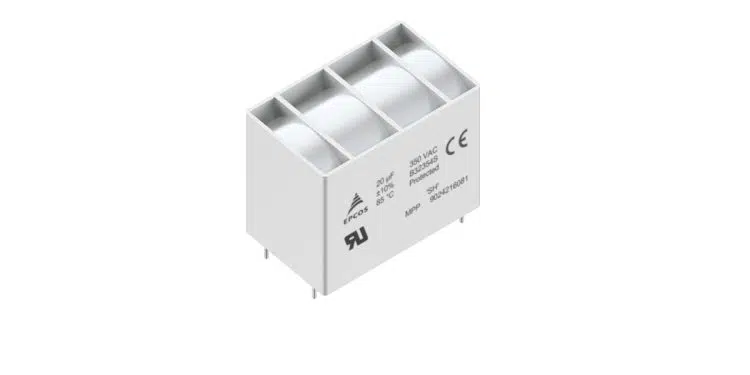TDK offers now rugged AC filter film capacitors with highest safety approvals (10,000 AFC and UL810).
TDK Corporation has added the B32354S* series to its portfolio of metalized EPCOS polypropylene (MKP) film capacitors for filter applications. The new devices, which feature a 4-pin design and a pitch of 52.5 mm, are rated for VRMS of 275 V AC or 350 V AC and cover a capacitance range from 10 μF to 40 μF. The maximum operating temperature is 85 °C.
The new AC film capacitors feature compact dimensions, a high AC load capacity, and optimized dielectric strength. They impress with their high resistance to harsh operating conditions such as high humidity. By means of a THB test (Grade III Test B) according to IEC 60384-14:2013/AMD1:2016 with an operating temperature of 85 °C and a relative humidity of 85 percent at applied nominal voltage for 1,000 hours, reliability even under challenging external influences was proven.
Certified to IEC 61071, the capacitors offer a life of at least 100,000 hours and a very low failure rate of less than 5 FIT. With its integrated safety function, the new series meets the highest safety level (10,000 AFC) and is UL 810 approved. The capacitors carry the CE mark, and the housing and potting material comply with UL 94 V-0.
Typical applications for the rugged film capacitors include demanding filtering applications such as output filtering of frequency converters for drives, uninterruptible power supplies (UPS), and photovoltaic inverters.
Features
- Approval to the highest safety standard according to UL 810 (10,000 AFC)
- Approval according to UL 94 V-0, CE marking, certification according to IEC 60384-14:2013
- Life expectancy of at least 100,000 hours according to IEC 61071
- Low FIT rate <5
- Compact design
- High resistance to high humidity
Applications
- Output filters of frequency converters for drives, uninterruptible power supplies, and photovoltaic inverters
































